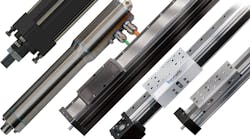Increased Demand for Uptime and Reliability Driving Move to Electric Actuators
Electric actuators offer a range of benefits, from efficiency to precise control. As such, they continue to gain market share in a variety of applications.
The benefits provided by electric actuators is increasing their use in place of hydraulic or pneumatic options as well, especially as manufacturing and other sectors automate more processes and machines which require the precision these devices provide.
Power & Motion spoke with Andrew Zaske, Vice President of Sales and Marketing at Tolomatic, about the market and technology trends the company sees impacting electric actuators now and in the coming year.
*Editor's Note: Questions and responses have been edited for clarity.
Power & Motion (P&M): What trends or market factors do you feel had the largest impacts on electric actuator designs in 2023? Please explain what those trends are and how specifically they impacted the design of electric actuators?
Andrew Zaske (AZ): This industry is dynamic, but when moving mechanical industrial parts and systems in manufacturing environments, there is caution exercised by the customers and the manufacturers to insure they ‘get it right.’ This means that the industry tends to, perhaps, move slower in changes from year to year.
No doubt the increasing demands of uptime, repeatability and reduced maintenance are some of the drivers moving people to electric and helping spur certain options and features in those electric products. Our grease zerk on the rod end of our actuators is valued by customers because the only maintence required is simple and doesn’t require removal from the system, disassembly or return to the factory.
P&M: How have you seen electric actuator designs evolve in recent years?
AZ: We see a growing interest in force capability. This means greater force, force repeatability and force accuracy. This has driven work to integrate load cells into some of our actuator designs. We have also extended the force range and work capacity of some our designs.
READ MORE: 3 Tips for Choosing the Right Electric Actuator for Hygienic Applications
P&M: What are some of the key features or performance attributes your company is working to include with its electric actuators, or for which customers are asking?
AZ: We are continuing to see growing interest in hydraulic replacement in new areas which are driving us to extend our ‘work’ capability with electric actuators. An example is our water-cooled option on some of our integrated motor actuator designs to remove motor heat from the system and allow for more aggressive work cycles.
Another example is our new option to add oil bath lubrication to our high-force actuators to allow them to double the amount of work they can do without adversely affecting the life of the roller screw.
P&M: How much, if at all, are you seeing electric actuators taking the place of hydraulic or pneumatic components or systems? Can you offer some examples, and how you possibly see this trend progressing?
AZ: We see a lot of interest in upgrading systems that were historically fluid power based over to electric actuation. Our feeling [is] that this is driven by several factors.
One driver is the promotion of younger engineers as the retirement rate as increased. These younger engineers are more comfortable with an electric system and willing to explore and embrace some newer technologies.
Another key driver is the interest in data and the realization that with electric actuation you get a tremendous amount of information about position, force, repeatability, etc. with minimal extra instrumentation…while being very energy efficient.
READ MORE: Comparing Electric and Fluid-Power Actuators
P&M: How do you see the electric actuators market in general performing in 2024?
AZ: Most of the industrial world came into 2023 with very strong backlogs of work. The appetite for capital investment seems to have been slowing throughout the year. This is likely due to over purchasing in 2021 and 2022, frequent price increases and rising interest rates.
2024 will be interesting as interest rates seem to stabilize and the USA enters an election year. The reshoring activity will continue for North America and actuators will be a key piece…so we are hopeful that confidence and appetite for investment will continue at a strong pace.
Get More Market Insights!
This article is part of our 2023 State of the Industry coverage which reviews the market and technology trends impacting the development of hydraulic, pneumatic and electric motion systems.
Visit our State of the Industry hub for more Q&As, video interviews and industry insights.
About the Author
Sara Jensen
Executive Editor, Power & Motion
Sara Jensen is executive editor of Power & Motion, directing expanded coverage into the modern fluid power space, as well as mechatronic and smart technologies. She has over 15 years of publishing experience. Prior to Power & Motion she spent 11 years with a trade publication for engineers of heavy-duty equipment, the last 3 of which were as the editor and brand lead. Over the course of her time in the B2B industry, Sara has gained an extensive knowledge of various heavy-duty equipment industries — including construction, agriculture, mining and on-road trucks —along with the systems and market trends which impact them such as fluid power and electronic motion control technologies.
You can follow Sara and Power & Motion via the following social media handles:
X (formerly Twitter): @TechnlgyEditor and @PowerMotionTech
LinkedIn: @SaraJensen and @Power&Motion
Facebook: @PowerMotionTech

Leaders relevant to this article:


